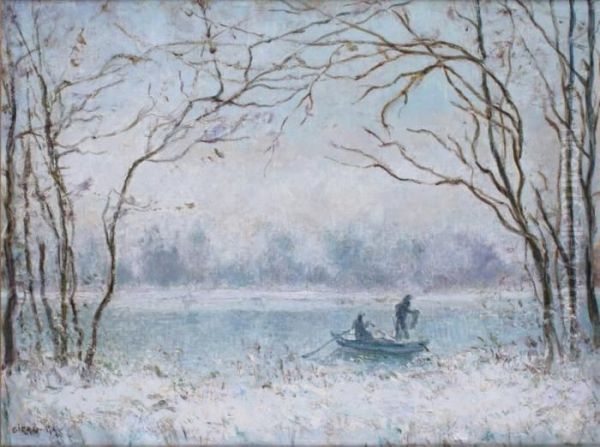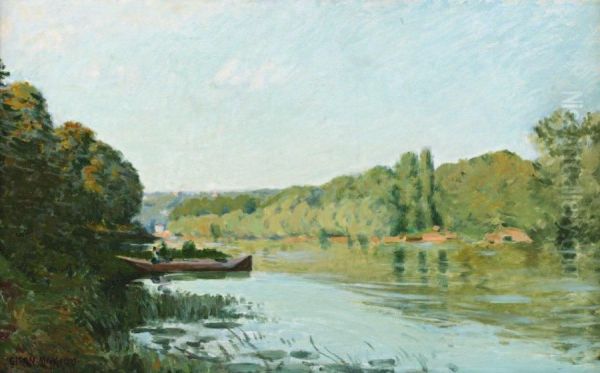Léon Giran-Max, a notable French painter born in Paris in 1867 and passing in 1927, carved a distinct niche for himself within the vibrant art world of the late 19th and early 20th centuries. His oeuvre is celebrated for its evocative depiction of natural landscapes, characterized by a robust use of color and a keen sensitivity to the interplay of light and atmosphere. Giran-Max's artistic journey saw him explore the picturesque riverbanks of France, the sun-drenched terrains of Spain, the rugged beauty of Brittany, and the idyllic charm of the French Midi, leaving behind a legacy of works that continue to captivate audiences.
Early Life and Artistic Inclinations
Born into the bustling cultural heart of Paris, Léon Giran-Max was immersed in an environment ripe with artistic innovation and tradition. While specific details of his early training remain somewhat elusive in comprehensive historical records, his development as an artist was clearly shaped by the prevailing currents of his time. The late 19th century was a period of immense artistic ferment, with Impressionism having already revolutionized the perception and depiction of light and nature, and Post-Impressionist movements exploring new avenues of expression, color, and form.
It is highly probable that Giran-Max absorbed these influences, perhaps through formal study at one of Paris's esteemed art academies or through more informal associations with contemporary artists. His choice of subject matter—primarily landscapes—and his stylistic approach suggest an affinity with painters who sought to capture the fleeting moments of nature, yet with a personal inflection that moved beyond mere mimesis. His brother, Emile Georges Giran, was also an artist, and it's plausible they shared artistic dialogues and perhaps even collaborated or supported each other's endeavors in the competitive Parisian art scene.
The Sanctuary of Neuville-sur-Oise

A significant chapter in Giran-Max's artistic life unfolded in Neuville-sur-Oise, a charming village nestled along the banks of the Oise River in the Val-d'Oise department. Here, he established a studio, finding inspiration in the gentle flow of the river, its verdant banks, and the changing seasons. This region, not far from Paris, had long attracted artists. Charles-François Daubigny, a precursor to Impressionism, famously painted from his studio boat, "Le Botin," along the Oise. Later, Camille Pissarro settled in nearby Eragny-sur-Epte, creating a wealth of Impressionist masterpieces, and Vincent van Gogh spent his final, intensely productive months in Auvers-sur-Oise.
Giran-Max's presence in Neuville-sur-Oise placed him within this rich artistic lineage. His studio was reportedly downstream from the residence of Octave Linet (1870-1962), another painter known for his landscapes of the Oise valley. This proximity suggests a shared appreciation for the local scenery and potentially an exchange of artistic ideas. The Oise River and its environs became a recurring motif in Giran-Max's work, allowing him to explore the nuances of light on water, the textures of foliage, and the tranquil atmosphere of riverside life.
Artistic Style: Color, Light, and Atmosphere
Léon Giran-Max's style is distinguished by its vibrant palette and his adeptness at capturing the essence of a landscape. His use of "strong colors," as noted by art commentators, suggests a departure from the more muted tones of academic painting and an embrace of the brighter, more expressive chromatic explorations seen in Impressionism and Post-Impressionism. He was not merely replicating reality but interpreting it, imbuing his scenes with a personal vision.
His paintings often demonstrate a profound understanding of light and its effects. Whether depicting a sun-dappled riverbank, the cool shadows of a winter scene, or the hazy light of a Spanish afternoon, Giran-Max showed a remarkable ability to convey mood and atmosphere through his handling of light and shadow. This sensitivity aligns him with the Impressionists' core concerns, though his compositions and color choices often possess a Post-Impressionist solidity and expressive charge. He primarily worked in oils, a medium that allowed for rich impasto and subtle blending, further enhancing the textural and luminous qualities of his canvases.
Key Themes and Representative Works
Giran-Max's thematic concerns were deeply rooted in the natural world. Rivers, in particular, held a special fascination for him, offering dynamic compositions and ever-changing reflections. His travels to Spain, Brittany, and the South of France provided him with diverse landscapes that he translated onto canvas with his characteristic vigor.

Among his notable works, Cueillette de coquelicots, bord de rivière à Neuville-sur-Oise (Poppy Picking, Riverside at Neuville-sur-Oise), painted around 1900, exemplifies his attachment to his Oise valley surroundings. This work likely captures the vibrant red of poppies against the lush greens of the riverbank, a scene of pastoral beauty rendered with his typical chromatic intensity.
Les Rameurs sous la Neige (The Rowers in the Snow), dated 1903, showcases his ability to capture a different mood and season. This painting would have explored the muted light and stark contrasts of a winter landscape, with the figures of the rowers providing a focal point against the snowy backdrop. The challenge of depicting snow, with its subtle blues and grays, and the reflections on icy water, would have appealed to his interest in light.
Children at Pond's Edge (1902) suggests an interest in genre scenes within a natural setting, a common theme among painters of this era who sought to capture moments of everyday life and innocence. The interplay of figures within the landscape would have offered opportunities for compositional exploration and the depiction of youthful vitality.
Another significant piece, Bord de l'Oise (Banks of the Oise), also from 1903, further underscores his deep connection to this river. Such works collectively form a visual diary of his time in Neuville-sur-Oise, reflecting his sustained engagement with its specific topography and atmosphere. These paintings, often featuring the Oise, its bridges, and surrounding villages, are central to his legacy.
Exhibitions and Recognition
Léon Giran-Max was an active participant in the Parisian art world, exhibiting his work in several prestigious venues. In 1898, he held a significant solo exhibition at the Le Barc de Boutteville gallery. This gallery, run by Louis Léon Le Barc, was an important venue for avant-garde artists during the 1890s. It showcased works by members of the Nabis group, such as Pierre Bonnard, Édouard Vuillard, Maurice Denis, and Paul Sérusier, as well as artists associated with Symbolism and Synthetism, like Émile Bernard. Exhibiting at Le Barc de Boutteville placed Giran-Max in the company of progressive artists who were challenging academic conventions and forging new artistic paths.
He also regularly exhibited at the Salon de la Société Nationale des Beaux-Arts (often referred to simply as the "Nationale") and the Salon des Indépendants. The Société Nationale des Beaux-Arts was established in 1890 as a more liberal alternative to the traditional Salon des Artistes Français, attracting artists like Auguste Rodin, Pierre Puvis de Chavannes, and Carolus-Duran. The Salon des Indépendants, founded in 1884 by artists including Georges Seurat, Paul Signac, and Odilon Redon, operated on a "no jury, no prizes" principle, offering a platform for a wide range of innovative styles, most notably Pointillism and early Fauvism. Giran-Max's participation in these Salons demonstrates his engagement with the contemporary art scene and his desire to present his work to a wider public. His contributions were recognized, and he reportedly received honors in 1928, posthumously, which speaks to the lasting regard for his work.
Contemporaries and Artistic Milieu
Giran-Max's career unfolded during a period of extraordinary artistic diversity. He would have been aware of, and likely interacted with, a wide spectrum of artists. His proximity to Octave Linet in Neuville-sur-Oise has already been noted. The broader artistic community of the Oise valley included figures like Ludovic Piette, a friend of Pissarro, who also painted the region.
His exhibitions at Le Barc de Boutteville connect him to the circle of Post-Impressionists and Symbolists. While his style may not have directly mirrored that of the Nabis, the gallery's ethos of supporting innovative art would have resonated with him. Artists like Henri Martin or Gustave Loiseau, who developed personal Post-Impressionist styles focusing on landscape and light, might be considered stylistic contemporaries in their approach to capturing the French countryside.
His participation in the Salon des Indépendants would have exposed him to the radical color experiments of the Fauves, such as Henri Matisse, André Derain, and Maurice de Vlaminck, who himself had strong ties to the Seine valley landscapes. While Giran-Max's colorism was strong, it generally remained more anchored in observed reality than the arbitrary, emotionally driven color of the Fauves.
His travels to Spain would have brought him into contact, or at least awareness, of Spanish artists like Joaquín Sorolla, renowned for his luminous beach scenes, or Ignacio Zuloaga, known for his more somber, dramatic depictions of Spanish life. Similarly, his work in Brittany would have placed him in a region rich with artistic history, famously associated with Paul Gauguin and the Pont-Aven School, whose members, including Émile Bernard and Paul Sérusier, sought a more synthetic and symbolic approach to painting. The South of France, a magnet for artists seeking brilliant light, had attracted Van Gogh to Arles, Signac to Saint-Tropez, and later, Matisse and Derain to Collioure. Giran-Max's engagement with these diverse locales reflects a common artistic pilgrimage of the era.
The Enduring Appeal of Giran-Max's Art
Léon Giran-Max's paintings continue to be appreciated for their aesthetic appeal and their contribution to the tradition of French landscape painting. His works appear in auctions, indicating a sustained interest among collectors. For instance, a depiction of Neuville-sur-Oise was estimated at a respectable sum in a 2023 auction, and Les Rameurs sous la Neige also garnered attention in the art market. These sales reflect the enduring value placed on his skillful rendering of light, his vibrant use of color, and his evocative portrayal of specific French locales.
His dedication to capturing the essence of the Oise valley, in particular, provides a valuable visual record of the region at the turn of the 20th century, seen through the eyes of a sensitive and skilled artist. While perhaps not as widely known internationally as some of his more famous contemporaries like Claude Monet or Pierre-Auguste Renoir, Giran-Max holds a secure place among the many talented painters who contributed to the richness and diversity of French art during this dynamic period.
His ability to convey the atmosphere of a place, whether the tranquil riversides of northern France or the sunnier climes of the Mediterranean, speaks to a universal appreciation for nature's beauty. His paintings are more than mere topographical records; they are personal interpretations, imbued with emotion and a distinct artistic vision. The "strong colors" that characterize his work are not just descriptive but also expressive, conveying the vitality and spirit of the landscapes he so clearly loved.
Legacy and Conclusion
Léon Giran-Max (1867-1927) was an artist who, while perhaps not a radical innovator in the mold of Picasso or Matisse, was a highly accomplished painter who absorbed the lessons of Impressionism and Post-Impressionism to forge a personal style. His commitment to landscape painting, particularly his evocative scenes of the Oise River, Spain, Brittany, and the South of France, marks him as a significant chronicler of his environment. His participation in important Salons and his solo exhibition at Le Barc de Boutteville attest to his active role in the art world of his time.
His work serves as a reminder of the depth and breadth of artistic talent flourishing in France at the turn of the 20th century. Artists like Giran-Max, who may not always dominate the grand narratives of art history, nonetheless played a crucial role in developing and disseminating new ways of seeing and representing the world. His paintings, with their luminous color and atmospheric depth, continue to offer viewers a window onto the landscapes he cherished, rendered with a skill and passion that ensures their lasting appeal. He remains a respected figure, particularly for those who appreciate the nuanced beauty of French Post-Impressionist landscape painting. His legacy is preserved in his canvases, which speak of a deep connection to nature and a mastery of his craft.